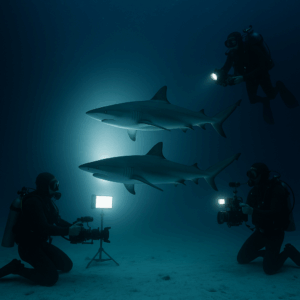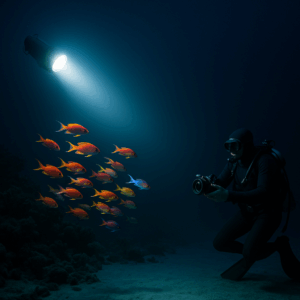Introduction
Underwater filmmaking is a breathtaking fusion of art and science. Whether capturing coral reef documentaries or shooting action scenes in the ocean depths, underwater cinematography demands tools that can survive and perform in extreme conditions. Chief among these tools is lighting.
Lighting underwater isn’t just about brightness—it’s about delivering the right kind of light, consistently and safely, at depths where natural light disappears and environmental variables become complex and dangerous.
In this article, we break down the critical features that define the best LED light for deep water film sets, giving filmmakers the insight needed to choose the right gear for mission-critical underwater shoots.
Filming underwater is vastly different from working on land. Once you submerge past 5 meters, the environment begins to absorb and scatter light. By 20 meters, red, orange, and yellow wavelengths are mostly gone. Colors flatten. Shadows disappear. Everything looks blue or green.
At deeper depths—like 25 to 50 meters or more—filmmakers face:
Ordinary lights don’t stand a chance here. The only solution is a purpose-built underwater LED light engineered for deep water performance.
The most fundamental feature is waterproofing, but that’s only the beginning.
IP68 or IP69K Waterproof Ratings
These are the gold standards. IP68 means the device can be submerged beyond 1 meter continuously. IP69K adds resistance to high-pressure water jets and steam, which also signals high structural integrity.
Pressure Resistance
At 25 meters, pressure exceeds 2.5 atmospheres. Deep water LED lights must be sealed using:
Material Selection
This rugged housing is what allows the light to remain operable, even under crushing water pressure.
Once depth strips away natural light, you must bring your own. But not just any light—it must be accurate.
CRI and TLCI Ratings
RGBWW or RGB+White Adjustable Spectrum
Top-tier underwater LED lights allow users to tune:
Underwater, spectrum control means the difference between a flat, monochrome shot and a vibrant, story-rich frame.
Deep water is dark—very dark. You need both raw power and beam shaping to light effectively.
Lumen Output
Beam Angles
Diffusion and Accessories
Use barn doors, diffusers, and gels to soften edges or mimic natural light flow.
LEDs generate heat—even underwater. Ironically, water helps and hinders cooling.
Passive Cooling
Underwater, water acts as a heat sink. High-end lights use aluminum fin housings or sealed copper cores to dissipate heat naturally.
Active Cooling
Some larger lights include liquid-filled cooling chambers or internal water loops for temperature regulation.
Thermal Protection
Essential safety systems include:
This ensures consistent operation even during prolonged shoots.
Powering a light underwater adds logistical complexity.
AC vs. DC Options
Battery Integration
Battery-powered models should offer:
Waterproof Cabling
Power cables must use:
A quality underwater LED setup minimizes risk and maximizes uptime.

On land, DMX512 control is standard. Underwater, it’s more complex—but still possible.
Underwater DMX and RDM Control
Some lights feature:
Remote Operation
For surface-based control, users rely on:
Manual Controls
When divers operate lights directly:
Lighting setups need to be fast, flexible, and safe underwater.
Weight and Form Factor
Mounting Options
Modular Design
Some lights are built to:

Saltwater is ruthless. Only the most durable lights survive repeated dives.
Corrosion Resistance
Maintenance-Friendly Design
Service Life and Warranty
A professional-grade underwater light should:
Documentary Filmmaking – Coral Reefs (BBC Blue Planet)
Feature Film – Action Scene at 30 Meters
Scientific Dive Projects
Behind-the-Scenes
Conclusion
Deep water filmmaking is a realm where ordinary tools fail and only exceptional engineering succeeds. The best LED lights for underwater film sets share a set of critical features:
✅ IP68+ waterproof and pressure-resistant housings
✅ High CRI/TLCI and adjustable RGBWW spectrum
✅ Intense lumen output and beam shaping
✅ Advanced thermal and power systems
✅ Reliable control and rigging options
When selecting a light, don’t compromise. You need a fixture built for deep environments—one that offers precision, safety, and durability in equal measure.
Call to Action
Looking to elevate your underwater film production?
👉 Explore our line of professional-grade underwater LED film lights
👉 Request a demo or quote today from our lighting specialists
👉 Download our Free Guide: “Underwater Lighting 101 for Cinematographers”
Let’s make the impossible visible—underwater.
–The End–
Get in touch for free lighting customization